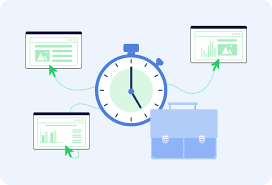Introduction
In today’s fast-paced, digital-first work environment, time is one of the most valuable resources. Managing it efficiently is crucial for boosting productivity, reducing costs, and staying competitive. That’s where time tracking software steps in.
This powerful tool is not just about monitoring hours worked — it’s about gaining insights into team efficiency, resource utilization, and operational bottlenecks. Whether you manage a remote team or run an in-office operation, time tracking solutions are rapidly becoming indispensable in modern business settings.
What is Time Tracking Software?
Time tracking software is a digital tool designed to monitor, log, and analyze how time is spent on various tasks, projects, and applications within a workday.
Unlike traditional punch cards or manual logs, these modern solutions automate the entire process. They help businesses visualize employee workflows, understand productivity trends, and even identify unproductive behaviors.
At its core, time tracking software offers real-time monitoring of work activity, ensuring transparency and accountability in today’s flexible and hybrid workplaces.
Benefits of Using Time Tracking Software
Implementing time tracking software offers a range of measurable benefits:
- Increased Productivity: Real-time feedback encourages employees to stay focused and manage their time better.
- Reduced Operational Costs: Identifies inefficiencies and time wastage, leading to cost savings.
- Improved Remote Work Management: Ensures accountability and visibility for off-site or hybrid teams.
- Data-Driven Decisions: Managers can make smarter strategic decisions using detailed time and productivity reports.
Ultimately, it empowers both employees and employers to work smarter, not harder.
Compliance and Privacy Considerations
With great data comes great responsibility. While time tracking software improves productivity, it must be implemented with ethical and legal boundaries in mind.
Transparent policies, employee consent, and secure data handling are essential. Tools like Kickidler also align with dlp meaning — protecting sensitive information while maintaining employee trust.
When done right, time tracking not only ensures compliance with labor laws and industry regulations but also strengthens overall data security and accountability.
Choosing the Right Time Tracking Software
Selecting the best tool for your organization depends on a few key factors:
- Scalability: Can the software grow with your team or organization?
- Integration Capabilities: Does it work with your existing CRM, project management, or payroll tools?
- User-Friendliness: Is the interface intuitive and easy to train teams on?
- Security and Support: Does it offer regular updates, encryption, and responsive customer support?
Kickidler, for example, is a feature-rich solution that meets these requirements and adapts well to various operational needs.
Trends and Future Outlook
The future of time tracking is both intelligent and seamless. Some key trends to watch:
- AI-Powered Analytics: Smart tools that suggest performance improvements based on behavioral data.
- Automated Task Classification: Automatically categorizes work activities for accurate reporting.
- Wellness & Work-Life Balance Features: Encourages healthy work habits by tracking overwork or burnout.
- Integrated DLP Systems: Ensuring both productivity and data security, reflecting deeper DLP meaning integrations.
As workplaces evolve, time tracking software is becoming more holistic — bridging performance management with employee well-being and compliance.
Related Questions
1. How does time tracking software improve employee productivity?
Time tracking software helps employees stay focused by increasing awareness of how time is spent. It also provides managers with insights to eliminate distractions and streamline workflows.
2. Is it legal to use time tracking software in the workplace?
Yes, it’s legal to use time tracking software if implemented transparently. Employers must inform employees and comply with local labor laws and data protection regulations.
3. What are the key features to look for in time tracking software?
Essential features include real-time time tracking, activity history, productivity reports, website/app monitoring, and integration with other tools like payroll or project management software.
4. Can time tracking software be used for remote teams?
Absolutely. Time tracking software is especially useful for managing remote teams by ensuring accountability, monitoring progress, and providing performance data across time zones.
5. How does time tracking software support compliance and data privacy?
Many platforms integrate Data Loss Prevention (DLP) features to secure sensitive information. Understanding the DLP meaning helps ensure software is used ethically and in compliance with privacy laws.
Conclusion
Time tracking software is no longer a nice-to-have — it’s a must-have for any organization that values transparency, efficiency, and agility. From boosting productivity to ensuring data privacy, the right solution brings significant ROI.
Whether you’re managing a startup, a remote team, or a large enterprise, adopting a robust time tracking software platform like Kickidler can transform how you operate and grow.
Now is the time to invest in tools that give you a clearer picture of where your time and resources go — and how to make the most of them.


